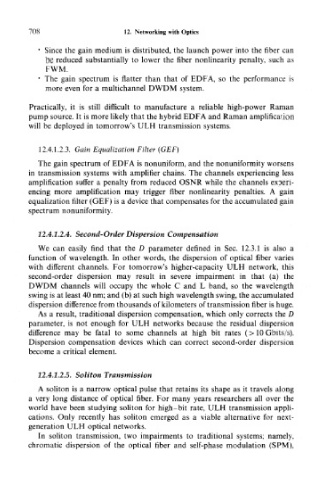Page 724 - Introduction to Information Optics
P. 724
708 12. Networking with Optics
• Since the gain medium is distributed, the launch power into the fiber can
be reduced substantially to lower the fiber nonlinearity penalty, such as
FWM.
• The gain spectrum is flatter than that of EDFA, so the performance is
more even for a multichannel DWDM system.
Practically, it is still difficult to manufacture a reliable high-power Raman
pump source. It is more likely that the hybrid EDFA and Raman amplification
will be deployed in tomorrow's ULH transmission systems.
12.4.1.2.3. Gain Equalization Filter (GEF)
The gain spectrum of EDFA is nonuniform, and the nonuniformity worsens
in transmission systems with amplifier chains. The channels experiencing less
amplification suffer a penalty from reduced OSNR while the channels experi-
encing more amplification may trigger fiber nonlinearity penalties. A gain
equalization filter (GEF) is a device that compensates for the accumulated gain
spectrum nonuniformity.
12.4.1.2.4. Second-Order Dispersion Compensation
We can easily find that the D parameter defined in Sec. 12.3.1 is also a
function of wavelength. In other words, the dispersion of optical fiber varies
with different channels. For tomorrow's higher-capacity ULH network, this
second-order dispersion may result in severe impairment in that (a) the
DWDM channels will occupy the whole C and L band, so the wavelength
swing is at least 40 nm; and (b) at such high wavelength swing, the accumulated
dispersion difference from thousands of kilometers of transmission fiber is huge.
As a result, traditional dispersion compensation, which only corrects the D
parameter, is not enough for ULH networks because the residual dispersion
difference may be fatal to some channels at high bit rates (> lOGbits/s).
Dispersion compensation devices which can correct second-order dispersion
become a critical element.
12.4.1.2.5. Soliton Transmission
A soliton is a narrow optical pulse that retains its shape as it travels along
a very long distance of optical fiber. For many years researchers all over the
world have been studying soliton for high-bit rate, ULH transmission appli-
cations. Only recently has soliton emerged as a viable alternative for next-
generation ULH optical networks.
In soliton transmission, two impairments to traditional systems; namely,
chromatic dispersion of the optical fiber and self-phase modulation (SPM),

